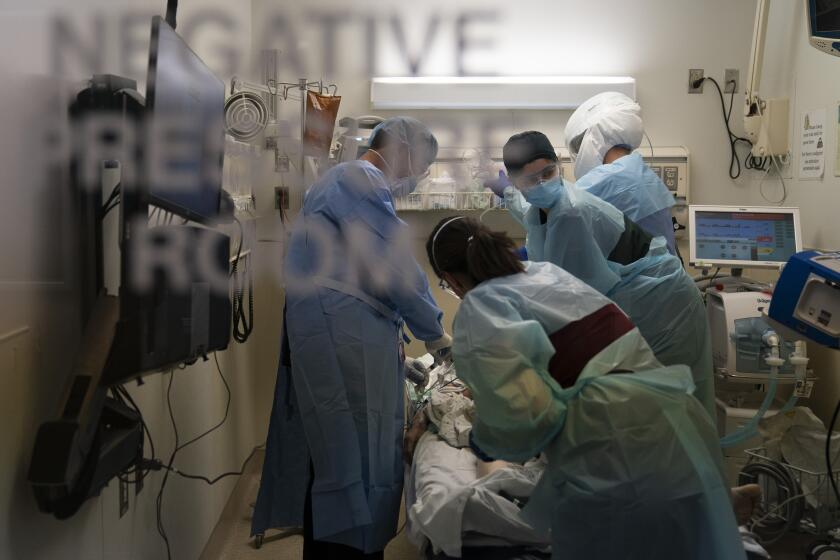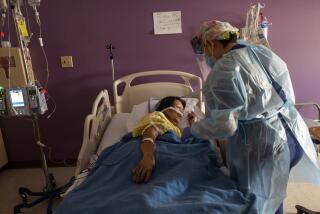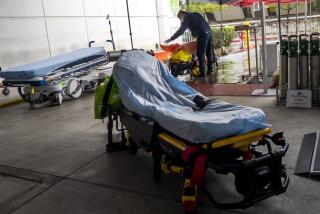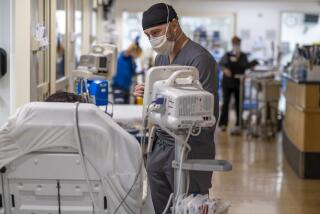Hospital ICUs full in Silicon Valley, Central Valley as California braces for more
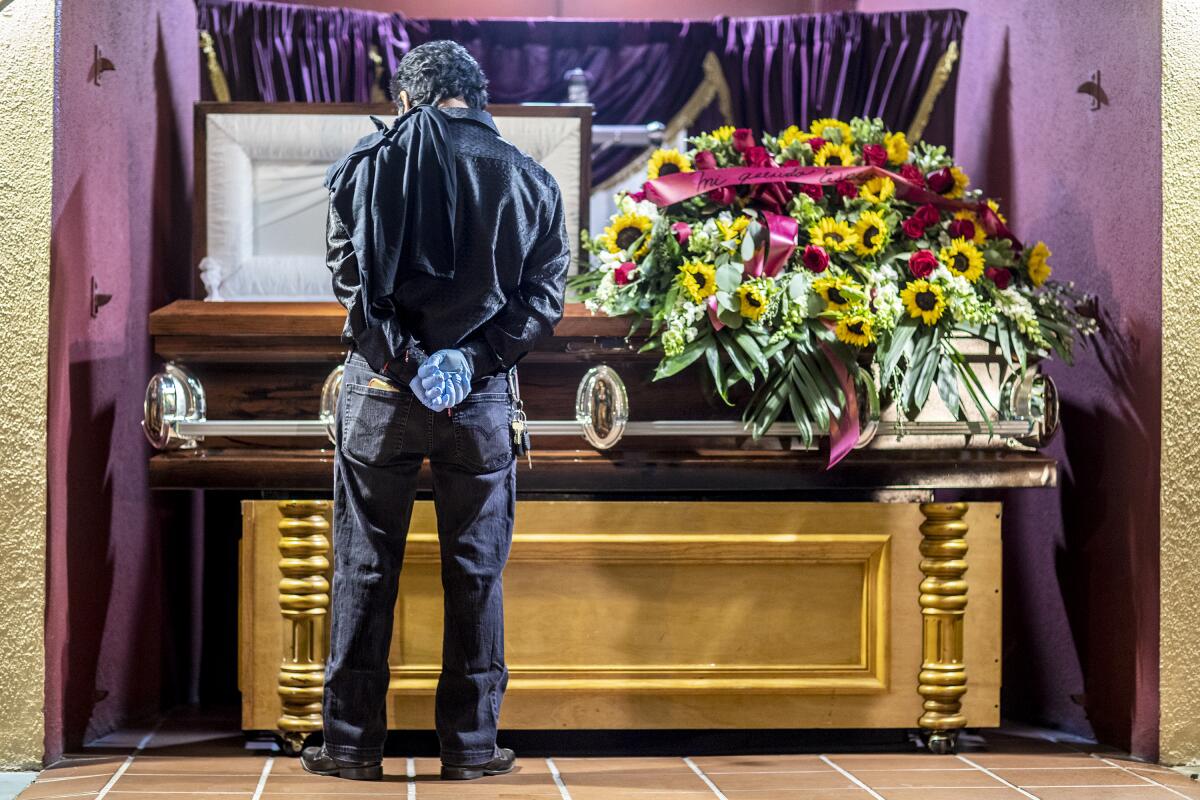
- Share via
SAN FRANCISCO — From Silicon Valley to Fresno, hospital intensive care units began reaching capacity Tuesday as California continued to set new records for coronavirus cases that officials fear will get worse in the coming days.
The high transmission rates come after weeks of warnings that hospitals could be overwhelmed as serious coronavirus cases spike to unprecedented levels. Officials warn the ICUs that filled up could be just the beginning.
The situation elsewhere in the state was somewhat better but still critical. Capacity remained at about 10% in Southern California, 24% in the Bay Area, 19% in the Sacramento region but less than 6% in the Central Valley.
Meanwhile, the state hit grim new milestones. California surpassed 20,000 deaths and Los Angeles County surpassed 8,000 deaths. California reported 35,400 new coronavirus cases on Tuesday, according to a Times county-by-county tally, and 219 deaths — both records for a single day. The latest tally means an average of 135 Californians have died each day over the past week — a number not seen since August — and nearly 25,000 people tested positive for the virus daily, a figure more than twice as bad as the peak of the summer surge.
About 1 in 8 of those testing positive are expected to need hospital care in the coming weeks as the virus further replicates in their bodies, causing illnesses like pneumonia and shortness of breath, and in severe situations, respiratory failure and failure of multiple organs.
Officials expect cases and hospitalizations to keep rising as more people who got sick during Thanksgiving show symptoms. They urged residents to follow new stay-at-home rules in effect for 84% of California’s residents, which officials said marked the best hope for bending the curve.
“Our message is: As much as you can, stay at home,” Dr. Mark Ghaly, California’s health and human services secretary, said Tuesday. “We know that it works. We know that we can bring our transmission rates down.”
At least three counties in the San Joaquin Valley have reached 0% capacity in their hospitals’ intensive care units, making the state’s agricultural hub the first area in California to become maxed out.
With a population of almost 1 million people, Fresno County faces a potentially dire situation, overshadowing its smaller neighbors Madera County, to the north, and Kings County, to the south.
“All the things that you’re hearing about how impacted our hospitals are, about how dire this situation with our ICUs is: it’s absolutely true,” said Dr. Rais Vohra, Fresno County Department of Public Health’s interim health officer. “That really is the reason that we want everyone to stay home as much as possible, at least for the next few weeks, until we get this surge under control, as we try to work through the hospitalizations that are just coming in so quickly and try to provide the best care.”
ICU beds come with specially trained healthcare professionals and high-tech equipment that can mean the difference between life and death for very sick patients. They are especially critical for patients with severe cases of COVID-19, who may require ventilators and round-the-clock care.
Vohra emphasized that the 0% capacity is a “snapshot in time” — the number changes as patients shift to higher or lower levels of care.
With ICU capacity depleted, patients with serious COVID-19 cases may take up open beds in the emergency department, said Fresno County emergency medical services director Dan Daniel J. Lynch. He said the county expects to activate an alternate care site for overflow patients at the Porterville Developmental Center on Monday. The facility, which can hold 123 people, would begin with 20 to 25 patients while waiting for ICU staffing to ramp up.
When asked about staffing shortages at hospitals in the San Joaquin Valley during a Tuesday news conference, Ghaly said it has been getting more difficult to secure additional staffing when counties call for help.
“We’re fulfilling what we can. But it is getting harder. We know that staff is our main scarce resource,” Ghaly said. “Our requests, both across the state and the nation, are hard to fulfill because of what’s happening across America with COVID.”
Nonetheless, with the extreme shortage of ICU staff in the San Joaquin Valley, the region is a priority for additional staffing requests, Ghaly said.
The ICU shortage was a devastating blow for California’s 10th most populous county, after almost 10 months battling the contagion. Miguel Arias, president of the Fresno City Council, said he and his colleagues have been working furiously to avoid reaching this point. They have fined businesses that violate health orders, distributed protective equipment and sanitizers and asked people to wear masks and maintain social distance.
“Even with all that, we have come to a point where, Monday, we officially reached that epicenter that we’ve all been trying to avoid,” Arias said in an interview Tuesday.
In Santa Clara County, the situation at hospitals was also deteriorating. On Tuesday, Santa Clara County was down to only 31 available intensive care unit beds — just 9.5% of its capacity — to serve Northern California’s most populous county, home to nearly 2 million people.
“It is the worst we have seen, and it’s continuing to worsen,” said Dr. Ahmad Kamal, Santa Clara County director of health preparedness. “Hospitals are nearing capacity, our staffing is stretched thin — not just in our county, but throughout the state and throughout the nation.”
Hospitals have started to cancel scheduled surgeries to create more capacity for the sickest patients. By noon Tuesday, there were more than 400 coronavirus-positive patients in Santa Clara County’s hospitals, including 12 children.
There were fewer than 100 before election day, Nov. 3.
“We are continuing to see a massive increase,” Kamal said. “We have more than doubled our ICU census in the last two weeks. Our system cannot withstand another doubling.”
Even more alarming than the hospitalized patient total is how fast ICU beds are filling. “Much more concerning than the low vacancy is the rate at which we are filling. As of today, 8 out of 10 hospitals have fewer than five ICU beds remaining, with some having zero,” Kamal said.
Officials may seek to open up beds at DePaul Health Center to treat up to 36 sub-acute patients and ask patients to collect their own specimen samples to free up clinical staff. Santa Clara County is also looking for additional staff from the state or National Guard, although state officials have warned that the supply of extra medical staff is limited.
Latino residents were nearly three times as likely, and Black residents nearly twice as likely, to be hospitalized with COVID-19 as white residents.
The new stay-at-home order imposed this week requires affected communities to limit most retail capacity to 20% and to close hair salons, nail salons, public outdoor playgrounds, card rooms, museums, zoos, aquariums and wineries. Restaurants are able to offer only takeout or delivery as indoor and outdoor dining are banned.
The new order has prompted a backlash from some merchants, including restaurant owners who say the suspension of outdoor dining in L.A. County in unfair and could destroy their businesses.
Photos look back at 2020’s wild ride in the Golden State.
In a decision announced Tuesday, a judge curtailed an outdoor dining ban issued by Los Angeles County officials, even as a state order that superseded the county order will keep the restriction in place past Christmas.
Regardless of the state’s order, if L.A. County wants to defend its outdoor dining ban, county public health officials must conduct a risk-benefit analysis to show the measure is warranted, L.A. Superior Court Judge James Chalfant said in his decision.
The state’s targeted stay-at-home order, which rolled out across most of California late Sunday, prevents outdoor restaurant dining until the critical shortage of ICU beds improves. The county should not be allowed to keep its own shutdown order indefinitely, the judge added.
The ruling arrives nearly a week after Chalfant ordered the county to provide scientific evidence justifying the ban that went into effect Nov. 25. The initial ban was scheduled to last only three weeks, but the county later made the restrictions indefinite, the judge said.
Lin reported from San Francisco, and Pinho, Seidman and Money from Southern California.
More to Read
Sign up for Essential California
The most important California stories and recommendations in your inbox every morning.
You may occasionally receive promotional content from the Los Angeles Times.
